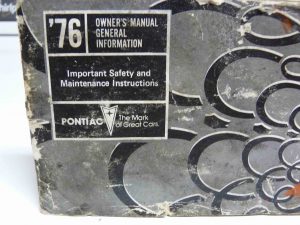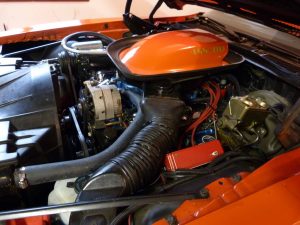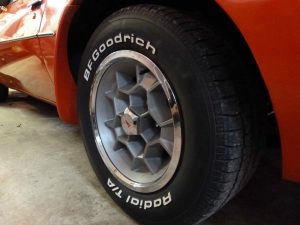New cars come with maintenance schedules that give you time/mileage intervals for things like oil changes, tune-ups, tire rotation and so on. Follow these recommendations and – assuming a decent/sound car to start with – it ought to be a long-lived car.
But what about old, semi-retired cars?
They came with maintenance schedules, too. But these assumed regular use. When that assumption no longer applies . . . what to do?
For example, my 1976 Trans-Am. I still have all the original paperwork, including the service schedule. It tells me to change the oil once every 7,500 miles or six months – whichever comes first. Well, it’ll take me at least a decade to rack up 7,500 miles – since the car only leaves the garage occasionally. I drive it about 500 miles each year.
I should probably change the oil more often than once every ten years.
But once every six months? Given maybe 250 miles or so of driving? That seems . . . wasteful.
And is.
Expensive, too. Oil – the good stuff – costs more than $10/quart and the old Pontiac takes six. Plus a filter. Plus tax – and it’s about $75 to change the oil . . . myself.
But the oil does need to be changed at some point. So – what point? I split the difference and do it once a year, regardless of the mileage. Even if the car has barely been driven at all.
In fact, precisely for that reason.
Not because the oil wears out. Oil is pretty much eternal, actually. But it does become diluted and contaminated, especially if it’s sitting in the crankcase of an old car with a carburetor perched on top. These invariably leak gas, which finds its way into the crankcase, where it dilutes the oil. And gas is not a lubricant. It is a solvent. This is not what you want mixed in with your lubricating oil.
There is also condensation – water – that mixes with the oil. Also not a lubricant. And, sludge – the bane of lightly/rarely-used cars. It can gum up the works, including the oil pump pick-up, which is usually located in the bottom of the oil pan. If the intake screen gets glutted up with the internal combustion equivalent of chunks of cholesterol . . . well, the results are actually kind of the same.
Which is why I change the TA’s oil once a year, no matter how few miles it’s been since the last oil change. I take it for a half-hour drive first, too. In order to thoroughly warm the engine so that the hot oil carries with it as much stuff-I-don’t-want in the crankcase out with it as possible when the drain plug is removed.
And I use synthetic oil (Amsoil, usually) because of the superior protection it provides, especially in a car that sometimes sits for weeks at a time. Synthetics stand up better to that kind of duty, in particular, the thin lubricating (and protective) film on critical wear surfaces such as bearings, cylinder walls and camshaft lobes.
Speaking of which . . .
If you own a car like my TA that has an engine with a flat tappet camshaft (as opposed to a roller camshaft) you should use an oil with the anti-wear additives – manganese and zinc – these engines require, but which have been eliminated from almost all over-the-counter engine oil, including the high-end synthetics.
This doesn’t mean they are not high-quality and using them in modern engines is no problem. But if you have an older engine with a flat tappet camshaft (generally speaking, this is American-brand stuff made before the early 1980s) then you should either buy an oil that has the additives (I use Amsoil’s Z-rod 10W30 in the TA) or buy a bottle of additive (GM sells it over the counter at dealers; there are other sources, too) and . . . add it to the oil at each changeout.
So, what else?
- Brake pads and shoes last almost forever when you only drive a few hundred miles each year. But brake fluid doesn’t. If you neglect to bleed the system – purge out all the fluid, from the master cylinder and lines – every three years or so – you are practically begging to have problems with your master cylinder, calipers, wheel cylinders and the steel lines – which will rust from the inside out if you leave old, contaminated (with water) fluid inside them for too long.

- Your radiator will last decades . . . if you regularly (every three years or so) drain/flush and refill the cooling system with fresh coolant. Don’t just top it off. Coolant does degrade over time. And ugly – costly – chemical reactions occur inside a radiator filled with decaying, Wilford Brimley fluid.
- Tires won’t go bald if the car is rarely driven . . . but they will flat spot if you leave the car unmoved for months. And they’ll get harder and crack-prone over time, regardless. You can delay this by keeping the sun off them, but exposure to air (and oxygen) will do the dirty work regardless. It is smart policy to chuck the tires for a new set after ten years, even if they still look new and have 90 percent of their original tread. Because they are old – and tired. Drive on them with caution, if you must – and not at high speeds.

- Batteries are meant to be regularly recharged, but that doesn’t happen if the car isn’t regularly driven. Starting the car drains the battery; but once the engine is running, the alternator generates electricity to keep the engine running and recharges the battery as you drive. . . if you drive long enough. If you just fire the car up and let it idle a few minutes (bad, do not do this) or drive it for just a few minutes before putting it back to bed (also not good) the alternator won’t be running long enough to fully recharge the battery and its life will be shorter, due to the fact of it being perpetually not fully charged.
- Most of all, drive the car. For 30 minutes, at least – once a month, at least. That will keep it limber, keep seals pliable, keep the battery charged, fresh fuel circulating (instead of rotting in the tank and lines and carb/FI system).
That is arguably the most important service schedule of all to stick to!
We are low this month (see here).
If you like what you’ve found here, please consider supporting EPautos.
We depend on you to keep the wheels turning!
Our donate button is here.
If you prefer not to use PayPal, our mailing address is:
EPautos
721 Hummingbird Lane SE
Copper Hill, VA 24079
PS: EPautos stickers are free to those who send in $20 or more to support the site. 











I bought my ’68 Oldsmobile with 47,000 original miles. It needed a ton of work because it spent most of its life in a garage.
Case in point: The transmission fluid had NEVER been changed in the car’s entire life. I changed it when I first bought it, along with the motor oil and coolant.
Soon after, the transmission started slipping. It turns out the pump was clogged with sediment and sludge, and the bands and clutch packs were disintegrating. So I had it rebuilt. I was planning on having that done at some point, and having my transmission shop install a shift kit, hi-cap pan, and auxiliary cooler, but I had to have it done sooner. Thankfully, the pump wasn’t damaged and could be cleaned, and the rest of the rebuild only involved “soft parts, and none of the more expensive “hard parts” like the pump or gear sets. Gotta love those Turbo Hydra-Matic 400s!
The owner’s manual called for only one transmission service at 50,000 miles — a mere fluid change.
If I recall, Chrysler’s manual mentioned that the TorqueFlite needed NO service at all!
I was surprised my 93 diesel pickup had no service for differentials or transmission(manual). I learned when I bought my first truck and noticed after 50,000 miles the transmission wasn’t shifting as smoothly as it had at 250,000 miles when I bought it. I was going to change the lube on it when a guy with more life experience told me since a transmission doesn’t need all the bs for sheer that rear-ends need I’d get a slicker transmission using mineral oil. I tried it and he was right. I sometimes changed that cheap mineral oil every 50,000 miles and every time it slicked it up. It was a small price to pay to keep a big rig on the up and up.
That reminds me of a friend’s mother, who back in the late 90’s paid DOUBLE the going price for a very low-mileage bubble Caprice which was owned by it’s original elderly owner and was rarely used. I told her not to do it…she didn’t listen. That car turned out to be the biggest pile of crap… -nothing but carbon build-up and dried-out seals and rusting from the inside out. She could hardly give that car away a year or two later, after all she paid for it and after all she put into it.
And by-the-way, Eric, I’ve never really been a T/A fan…but after seeing yours, I kinda want one!
Great article, Eric!
NOTHING kills a car faster/worse than just letting it sit [if ya don’t do proper maintenance]. For this reason, I’ve always tended to avoid buying “low-mileage” older cars, because [assuming they’re drivers and not collector/show cars] the average person who doesn’t drive much, just tends to let their car sit and rot- “Change the erl?! What fer? I haven’t driven it 1000 miles in the last year!”- and even worse, when they do drive, it’s probably just for a very short trip 😮 .
My sister is like that- She’s had a ’92 ‘Stang for about 20 years now. Sits in a parking lot by her apartment; gets driven a few blocks maybe once a week. I don’t think it’s turned 100K miles yet, and it’s just slowly rotting into the ground.
Sitting outside is bad. Being short tripped is bad. The conditions matter most. Problems can be avoided even with a low usage car if when they are driven they are driven a good long distance.
Oil changes are needed to remove the combustion by-products that get in it. If a car gets driven 50-100 miles at a time there’s no need to change oil based on time. It doesn’t break down in the sump any more than it does in the bottle.
So true, Brent. I only drive about 3K miles a year, and that’s spread between 2 vehicles- so they get very little use. When I do drive ’em, it’s usually 50 miles or so. So I really have to be a maniac about maintenance.
Most reliable vehicle I ever owned was one that had 240K on it when I bought it. Just sold it last year- after having it for 15 years- now with 300K on it- and it still ran like a top. All it ever needed over the years was a fuel pump and a heater core.
High-mileage fleet-maintained vehicles are great- they get driven every day, and have the best maintenance done. Most people have it backwards…they look for low-milers that were rarely driven- which not only means that they sat, but almost guarantees that maintenance was neglected.
Thanks Eric and this article was well timed as it reminds me of my guilt of negligence with my current old car, a 84′ Dodge Daytona TurboZ, which has basically been a giant paperweight in my driveway for the last 14 years. It’s a one owner car from VA. and I changed most of the fluids when I first got it and finally did the P/S and master cyl. fluids about 2 years ago (following the informative article you wrote using the” turkey baster” technique), but have been sorely lacking on doing the coolant and oil(Mobil 1) for a long time now. I try to use all the gas in it each year and do use the Sta-Bil fuel additive when I fill the tank, the problem is I’ve probably only put about 250 miles on it over the last 14 years and that was just driving it around my neighborhood but mostly the gas is just burned off with it idling in my driveway for an hour or two at a time. I was actually going to finally do the oil this year but the tires are so dry rotted I’m almost afraid to drive it up on the car ramps. I’ve done zero on the brakes since I’ve owned it but it only has 58K orig miles. I know I should be piston whipped for treating the car this way but I’m really going to try and get some things done on it this year. I’m really torn sometimes on just selling the thing but I have sort of a sentimental attachment to it since I had a new one in ’84. Love your T/A by the way, still remember some wild rides in my friend’s ’79.
Great article Eric. Thanks.
Thanks for the kind words, Joe!
Yes, it was a good article and you touched on the all the pertinent parts. I’d like to add, never crank up an engine and let it come to temperature without driving it 20 miles or so, otherwise, just leave it alone.
My parents were the ultimate car killers. Crank it up(didn’t matter what it was), drive a mile to town and let it get cold again or drive it back home from the post office. My dad would perform this car killing exercise a few times a day. The only thing that survived without expensive maintenance was the 55 Chevy pickup with a Blue Flame six. They would have a 2 year old car with rusted out exhaust in west Tx., testament to how badly they treated a car. I pulled the fuel pump off my dad’s S 10 once looking for his problem which was simply too many years of this type of abuse. A big black thing was all I had to show for what was in the crankcase. I’m thinking, how does this work? After cleaning it thoroughly I found it was a big spring but couldn’t have guessed at what I first had in my hands. Turns out that computer comtrolled carb had had all the abuse it could stand and nobody could fix it and I didn’t even try. Get a new carb or trade it was my advice and I pushed the trade it part. I was always and forever asking them if they didn’t have somewhere else they could have gone except that car killing route. They would look at me like I had started speaking Klingon. I made the point to them that my wife and I NEVER had to have new exhaust parts while they ruined a muffler every couple years and a tailpipe the year after like clockwork.
eric, have you ever had an oil analysis done on your 500 mile oil? It would be informative. I’ll be changing the oil and filter on our mower soon just because of how long it’s been in there with very few hours on it. It seems to really like the 4 cycle small engine oil Amsoil makes for it and I like the filters they sell too.
I know you know I’m a dedicated Amsoil guy and the Z71 with over 200K on the clock when I bought it had oil for high mileage cars in it. I immediately ran an Amsoil flush through it and then filled it with the recommended 5W 30 (Amsoil). It noticeably quietened the engine. Of course, I have no doubt that like all 5.3’s the top end is going to have to be replaced long before the bottom end needs anything but maintenance. I wonder if it has to be so. If anyone has a high mileage as in 300K or more 5.3 I’d be interested in how it achieved that and how it’s still doing. So many people do such stupid things to pickups it blows my mind. My ex-employer bought a used pickup with a 5.3 and it ran like a top. Oil change day rolls around and I tell the mechanic and everyone else who’ll listen(or won’t) to get some 5W 30 for it since that 15W 40 Rotella T will ruin the top end toot sweet. Next time I got in it it rattled like a tin lizzy since it had Rotella in it. One guy said defensively, What man? That Rotella is good oil. Yep,it is good oil for that Pete and the Volvo and International sitting there but it will kill the upper end of that 5.3 and all that noise you hear now is simply from using that oil. But you can’t fix a dumbass
I’ll be passing this article along to dad. The old Daytona gets run regularly but I’m fairly certain he’s never done anything to the brakes.
Eric, plenty of good words, and you raise some significant issues that few folks really understand. How many times have I had a customer who just bought some car that had been parked for some years, and they drove it home… only to begin a series of serious problems related to the long winter’s nap…. or, more like Rip van Winkel’s rest of many years. Oh the fun I have sorting out its many hidden ailments. And boats… oh YESS, boats that have been sitting over the witner “under cover” are reliably a scene…. but the poor sap buys one been sitting on blocks or a trailer on someon’es side yard for six years…….. thinks he’ll have her back in the water next weekend….. I LOVE those kinds of boats. They paid my mortgage for years.
One thing I learned, VERY painfully, many years ago….. when you are parking any vehicle for more than a week or two, never NEVER set the handbrake….. the cables are prone to sticking, thus locking the brake full on. Try moving the car that way. Leave it in gear…. an automatic, Park. A manual, especially if its an older model, second gear. Cables are far more easily freed up when the cable is not under tension by way of being set. With the cable itself loose in the housing it is less likely to seize up when left standing for months, even years. If the gound is rough or on a slope, blocks under the downhill “end” of the tyres will keep the beast tamed for a long time.
One other thing: I can’t quite get at your concern for a carburetted engine sitting, and the supposed effect of fuel dripping into the manifold then on down into the sump and diluting the lube oil…. consider: when the engine is not running, the fuel lift pump cannot supply more to the carburetter, whether electric or mechanical pump. Even the largest of monster dumpers can’t hold more than a cup at most in the float bowl. Most of that fuel will evapourate, excepting
Damn, what a coincidence that you speak of oil changes in old cars. Several hours ago I changed oil in my 89 Dodge pickup, and while letting it down apparently the jack cradle slipped off the axle. Bam!, but so what? When I backed it out of the garage, though, I found I suddenly had no brakes. In a couple of hours, sometime around dawn I’ll crawl underneath and see what the damage was.
I change oil every 3000 miles or once a year for the beaters that don’t get driven much. I figure I’ve changed oil some 200 times or more in my lifetime. Only once has an engine failed, and that was that used Ford truck I had (which I named the Antichrist), for which I paid pretty good money. As I’ve remarked before, synthetic oil may last longer but the gunk and crap that accumulate in oil are there no matter what oil you use, and the additives wear out just as quickly, so I figure relatively frequent oil changes with conventional oil are worthwhile. My only reservation is to hear a motor turn over when it’s 25 below zero and think of even winter weight oil moving like molasses.
The biggest problem by far that I have with my beaters is brakes. Suckers freeze up or otherwise malfunction frequently when the cars aren’t driven regularly, which is a hassle when you’re the world’s worst mechanic. Ah, well. Walter Chrysler never promised me a rose garden.
Eric
What do you think of STA-BIL 22264 360 Performance with vapour technology? I use it whenever I fill up my cars with petrol.
It was highly recommended to me by a friend but I would like to know your expert opinion.
Hi Arthur,
I use it myself – and strongly recommend it. Not only in cars but also outdoor power equipment such as mowers and riding tractors that sit for months during the off season. And my motorcycles – I have five.
That plus firing them up once a month and running them for at least 15 minutes has kept fuel degradation problems to a minimum for me.
The recommendations for RV tires (which also sit for more than they are driven) is to replace them every 7 years. You can go a little longer if you’re religious about using sun guards (keeps the UV off them).
And what about transmission, axle, slave cylinders fluids, the coolant overflow tanks. Fuel filter, esp. on metal gas tanks, wiper blades. These all need to factor into the maintenance too.
Great article Eric! Thank you.
My cars range from a 20k mile per year V8 Expedition to a spider like in the photo that has been sitting for years. The much-driven get Mobil 1 at 7000 miles or one year whichever comes first. Wife’s ’03 Liberty gets driven often, but never more than 4k per year; the 7.3 diesel F350 similar usage. At the other end, non-runners get cranked regularly to get some oil on the bearings. The in-between get driven less than monthly, more like 4 or 6 times per year. Good oil, move the tires, let the engine get hot, good gas. I have LOTS of restorations in front of me. Oh, and all that are not driven regularly are on trickle chargers.
Amen to your tire recommendation!
You have reminded my that I have to get on with coolant and brake fluid replacements, and I have to look into the additives in the oil I use in a ’72 Chevy 402!
Thanks once again!
Thanks for the kind words, Scott!
Brake pads love to rust in the brackets from sitting. Then You’ll have to push harder to stop and they can drag. Always grease under and over the anti-rattle clips. 6.0 diesel variable geometry turbos also will siezed from sitting.
Hmm .. I’ve changed the brake and radiator fluid approximately zero times on a 10 year old car — mebbe I’d better flush it soon.
What do you think of “High Mileage” oil? Is ti better than synthetic for an older car with < 200k?
Hi Alex,
A lot depends on the specific brand – and whether “high mileage” is a marketing gimmick or there is actually a different additive package in the oil, the quality of the oil, etc.
I personally regard a high quality synthetic as inherently “high mileage” because of the superior protection it provides; you can extend oil change intervals significantly and this amortizes the higher up-front cost of the oil. Also, there is the likely greater longevity (and better mileage, this is noticeable) you’ll see by using a high quality synthetic….